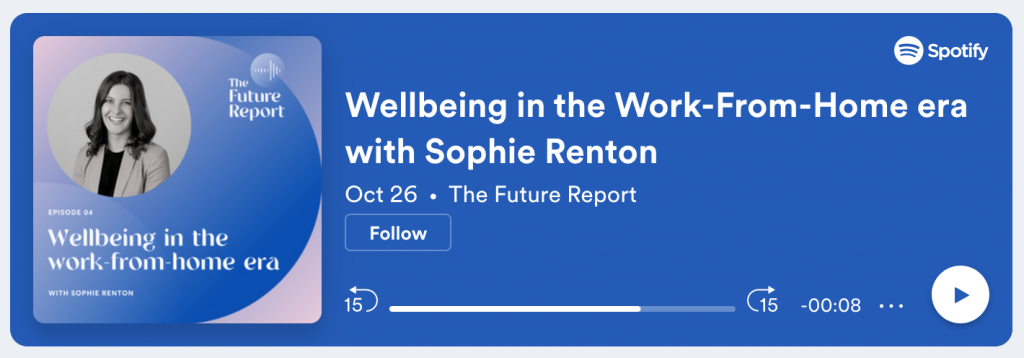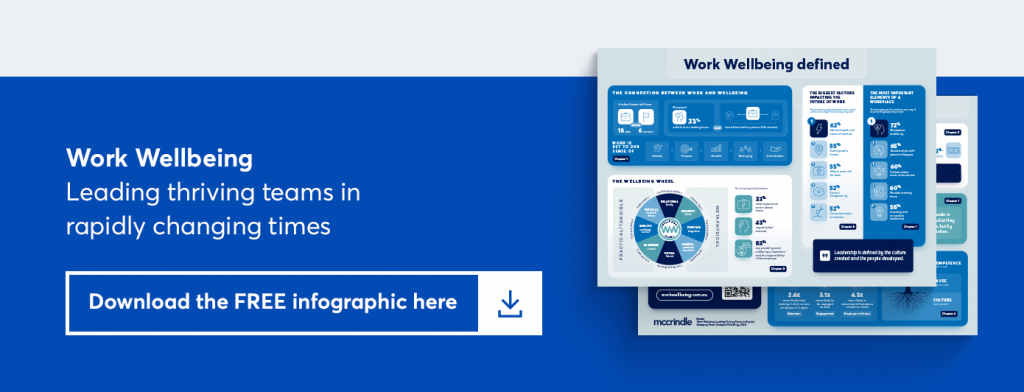By: McCrindle
Over the last few years, wellbeing has risen to the top of the agenda. It’s one of the key challenges and opportunities that our society faces. In any given week, we spend more than a third of our waking hours at work – so it’s the place that we most need to get wellbeing right.
When it comes to wellbeing and work, this became even more of an issue when COVID-19 necessitated the most transformational shift to work for perhaps a century. For the first time in modern history, working-from-home became the norm, and brought with it an increasing desire for this way of work in the future.
Listen: The Future Report podcast – Wellbeing in the Work From Home era with Sophie Renton
The future of work and working-from-home
For most employed Australians (62%), their ideal way of working is a hybrid style where part of the time is spent working-from-home and the other part is in the workplace. In many ways, the old arguments of people not being productive have been proven wrong over the last 24 months. People have continued to deliver outputs at a greater level and in a greater time of change than ever before. Therefore, we believe that the future of work won’t encompass a shift away from the office altogether. Rather, it will be about how to get the best of both worlds. It will be about utilising the work environment so that people are engaged and productive – whether that environment is in one’s home or in the workplace.

Different types of work are better suited to work-from-home VS the workplace
The widespread adoption of work-from-home demonstrated to many that people can still accomplish their work regardless of their location. But it should be noted that different locations can have an impact on the type of work being done.
Our research has shown that work-life balance, flexible working hours, deep thinking and reflection time are better achieved when working-from-home. In contrast, the workplace is better for collaboration, brainstorming, strategising and building strong relationships with colleagues. Therefore, leaders need to think about how the workplace is set up and clearly communicate their expectations for the type of work being carried out in the workplace and the work-from-home environment.
The benefits and challenges of working-from home
While many have adapted, it is important to acknowledge that there are both benefits and challenges of working-from-home. Some of the most widely acknowledged benefits include time-savings, money savings and flexible working hours. But alongside those benefits are some challenges, the biggest of which has been social isolation. With 70% of Australians saying their meaningful relationships are developed in the workplace, this is not surprising. Other challenges include the blurring of work and home boundaries and missed opportunities for collaboration.
Life stage is crucial when exploring people’s desire to work-from-home. For example, work-from-home may be appreciated by many Gen Y parents (when they are not also trying to home-school) because they’ve got greater demands on their time. Having flexibility is important to them, which means it’s not so much about when they are working as it is about getting the work done. When it comes to Gen Z, however, we’ve often found that they prefer being in the office because of the collaboration and community they experience when being in the same place as others.
Wellbeing when working-from-home
It is important to acknowledge that the work-from-home environment can amplify the impact of work on people’s wellbeing. Therefore, take a moment to reflect and recognise what your own strengths and weaknesses are and put practises in place to help with your wellbeing. For example, you could implement a different wind-down routine at the end of the day, in place of a commute. This could simply be going for a walk to help you switch off and transition out of work mode. Whatever it is, think about how you can build practises that help your overall wellbeing.
It’s also important to remember that, while the virtual world is very transactional, we all need the relational aspect of work. We are human beings after all, not human doings. It’s the human centric element of work that helps us to do our work better. And as a leader, if you’re finding that you don’t have a very engaged workforce, then you need to look at your level of connection, because connection precedes engagement.

Elements of engagement: Culture, purpose and impact
Focusing on culture, purpose and impact is a winning combination for great organisations – even in this work-from-home era. Culture can be described as how an organisation accomplishes what it does. It encompasses everything from regular routines to small, everyday moments. It is essential that leaders recognise that they are culture carriers. The role of a leader is to be enthusiastic and intentional about creating a workplace where people want to be every day. As a leader, if you don’t want to be at your workplace, then nobody does, so creating a culture and workplace that you want to be in is important.

If culture talks about the how, then purpose talks about the why. From our research, we know that people want to be involved in something bigger than themselves. A third of our waking hours is spent at work, and people want to invest that time into something that matters. As leaders, it is essential to be communicating the purpose of your organisation regularly, because that is what gets people engaged and involved.
And finally, great organisations measure their impact and the steps being taken towards the desired outcome. It also includes celebrating, coaching and challenging the people in the team.
The role of leadership in employee wellbeing
Great leaders don’t take their team members for granted. People help organisations get where they need to go, and so appreciating and valuing your team as the collective and as individuals, is important. It’s also important to be aware of people’s world, and what is happening outside the workplace. People don’t just turn off when they come to work. They have challenges that they carry. And while it is true and important to remember that workplace leaders are not counsellors, leaders can still play a helpful role in the lives of their team.
As a leader you can’t accomplish everything on your own. Rather, your job is to solve the problems and equip the team to thrive. Because as every person on the team begins to think like a leader, they see the challenges, opportunities and know the vision. They rise to the occasion; their engagement goes up and they contribute to something of value. When leaders see something in their team that they may not see in themselves, create opportunities for them and witness them go further than they ever thought they could, it is incredibly rewarding for the team as well as the leader.
Article supplied with thanks to McCrindle.
About the Author: McCrindle are a team of researchers and communications specialists who discover insights, and tell the story of Australians – what we do, and who we are.






